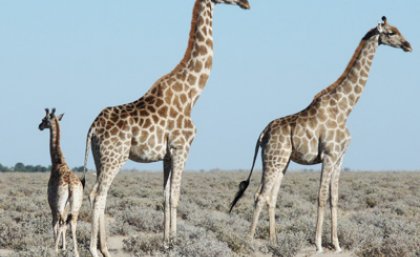
Studying social relationships among female giraffes may provide essential information for the management and conservation of the species, a study by The University of Queensland (UQ) has found.
Lead researcher, Ms Kerryn Carter, from UQ’s School of Biological Sciences observed the social groupings of 535 individually identified wild giraffes in Etosha National Park in Namibia for 14 months.
The study discovered that giraffes have more complex relationships and social networks than previously thought, and this is of importance to understanding the evolution of animal and human sociality.
“Giraffes show a fission-fusion social system, like humans, where individuals temporarily associate so that the numbers and identities of individuals in groups changes frequently," Ms Carter said.
“Until recently, giraffes were thought to show no apparent pattern to their relationships.”
Ms Carter looked at the frequency at which each giraffe pair associated, while taking into account how much their home ranges overlapped, and thus their ability to meet on a regular basis.
Her results have been published in the scientific journal Animal Behaviour.
“We found, rather than females interacting non-selectively as previously thought, individual female giraffes preferred to be in groups with particular females and avoided others,” Ms Carter said.
“Surprisingly, home range overlap and kinship together did not explain much about these female-female relationships.”
Females’ individual social preferences, their ages and their reproductive states may contribute to their choices of female associates.
Research is continuing on to understand which factors contribute to these preferences.
Understanding the patterns of social networks in species such as giraffes helps us understand how diseases may spread through a population and how individuals may learn about their environments from one another; such understanding is therefore important for conservation.
Such preferred and avoided relationships have been documented in other fission-fusion taxa such as eastern grey kangaroos, bottlenose dolphins, northern long-eared myotis bats and of course humans.
“These similarities in the social systems of these varied species are surprising given how much the ecology of these species differs,” said Ms Carter.
Media: Ms Kerryn Carter, +61 413104699, kerryn.carter@uqconnect.edu.au; Tracey Franchi, UQ School of Biological Sciences Communications Manager, +61 7 3365 4831, t.franchi@uq.edu.au.
Images for Publication: Images of male and female giraffes are taken at Etosha National Park by Kerryn Carter. More images available by emailing t.franchi@uq.edu.au
About the School of Biological Sciences
UQ has been ranked by the 2012 National Taiwan University Rankings in the top five universities globally for research in ecology and environmental biology and in the top 18 universities globally for plant and animal biology. The UQ School of Biological Sciences attracts researchers of world standing in a range of disciplines, with international leaders in many diverse fields. Our work spans the scales of biological organisation, from molecules and cells to organisms, populations, species and communities. With more than 150 researchers working in evolution, global change biology, ecology, aquaculture, animal behaviour, physiology, entomology, zoology, botany, genomics, developmental biology and conservation biology, our researchers and graduate scientists are well-equipped to make a real difference in contributing to solving global problems.
.jpg)



